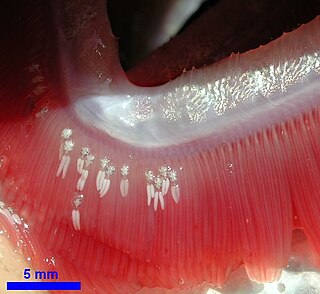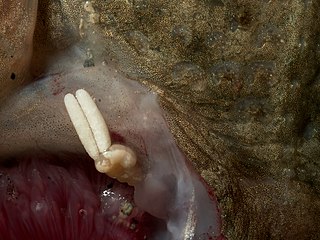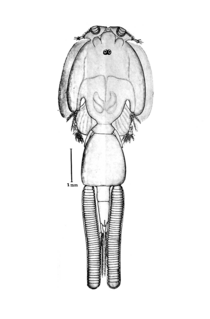Related Research Articles

Siphonostomatoida is an order of copepods, containing around 75% of all the copepods that parasitise fishes. Their success has been linked to their possession of siphon-like mandibles and of a "frontal filament" to aid attachment to their hosts. Most are marine, but a few live in fresh water. There are 39 recognised families:

Ergasilidae is a widespread family of copepods and comprises many species. The type genus is Ergasilus. With a few doubtful exceptions all ergasilids are parasitic on fishes.
Bomolochidae is a family of copepods parasitic on marine fishes. Most species parasitize the gills of fish, but some species live in the nostrils or on the eyes of their hosts. The family contains just over 150 species from the following genera:
Acantholochus is a genus of parasitic copepods belonging to the family Bomolochidae. Its members can only be distinguished from the closely related genus Hamaticolax by the absence of an accessory process on the claw of the maxillipeds.
Hamaticolax unisagittatus is a species of parasitic copepod belonging to the family Bomolochidae. It is a parasite on the gills of the common snook and has only been recorded in coastal waters off Rio de Janeiro State. In one study over half of the host fish sampled in this area carried this parasite.
Shiinoidae is a family of parasitic copepods. The first species in the family to be described was Shiinoa occlusa, a single immature female of which was discovered on the fish Scomberomorus commerson, and described by Kabata in 1968. A second species, S. inauris, was found on Scomberomorus regalis and described by Roger Cressey in 1975, who also erected the family to hold the genus Shiinoa alone. A second genus was added in 1986, containing the single species Parashiinoa mackayi, which had been found on the fishes Pomadasys maculatus and P. argenteus. Nine species are now recognised in the two genera:
Taeniacanthidae is a family of cyclopoid copepods in the order Cyclopoida. There are more than 20 genera and 120 described species in Taeniacanthidae.

Chondracanthidae is a family of parasitic copepods, usually found infecting the branchial chamber of demersal fishes. It comprises the following genera:

Caligus is a genus of sea lice in the family Caligidae. The species are parasites of marine fishes and could be vectors of viruses. As of 2017, the World Register of Marine Species includes the following species:
Argulus is a genus of fish lice in the family Argulidae. There are more than 130 described species in Argulus. They occur in marine, brackish, and freshwater environments. As juveniles, Argulus feed on mucous and skin cells of their host. With age they become blood feeders because the parasite moves from feeding on the fins to feeding on the body of the fish, causing the feeding change.
Nicothoe tumulosa is a species of copepod parasitic on the gills of the glypheoid lobster Neoglyphea inopinata. It was described as a new species in 1976 by Roger F. Cressey. It can be differentiated from related species by the setal formula, and the trunk's covering of small bumps, which give the species its name.
Lernaeopodidae is a family of parasitic copepods. The females are typically large and fleshy, and attach to the host permanently using a plug made of chitin called the bulla. The males cling on to the females using their antennae. The family contains the following genera:
Pennella is a genus of large copepods which are common parasites of large pelagic fishes. They begin their life cycle as a series of free-swimming planktonic larvae. The females metamorphose into a parasitic stage when they attach to a host and enter into its skin. The males are free swimming. Due to their large size and mesoparasitic life history there have been a number of studies of Pennella, the members of which are among the largest of the parasitic Copepoda. All species are found as adults buried into the flesh of marine bony fish, except for a single species, Pennella balaenopterae which can be found in the muscles and blubber of cetaceans and occasionally other marine mammals, and is the largest species of copepod.
Chondracanthus is a parasitic copepod genus in the family Chondracanthidae, containing the following species:
Acanthochondria is a genus of copepods, containing the following species:
Lepeophtheirus is a genus of sea louse. The best-known species is L. salmonis, the salmon louse. Other species include L. pectoralis, which uses flatfish as its host, particularly the European flounder, and is also the type species of the genus Lepeophtheirus.
Eudactylinidae is a family of copepods most of which live as parasites on the gills of elasmobranch fishes; two genera lives on the gills of teleost fishes. The family Eudactylinidae contains the following genera:
Eudactylina is a genus of copepods that parasitise elasmobranch fishes. It contains the following species:
Peniculisa is a genus of marine parasitic copepods in the family Pennellidae.
References
- ↑ F. N. Morales Serna & S. Gómez (2010). "A new bomolochid copepod parasitic on bullseye puffer Sphoeroides annulatus (Jenyns) from Mexico, with reassignment of some species of Acantholochus Cressey and Hamaticolax Ho & Lin" (PDF excerpt). Zootaxa . 2336: 36–50.
- ↑ T. Chad Walter (2011). Walter TC, Boxshall G (eds.). "Hamaticolax Ho & Lin, 2006". World of Copepods database. World Register of Marine Species . Retrieved November 30, 2011.